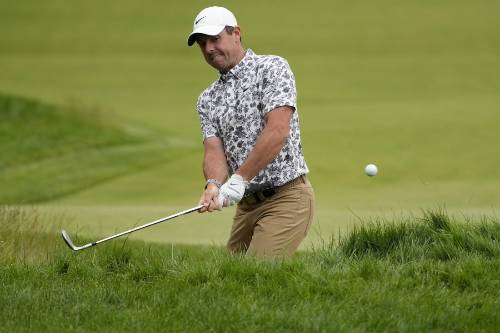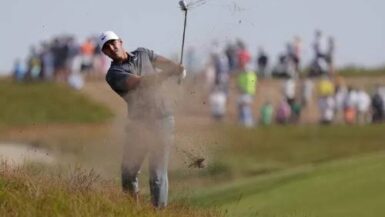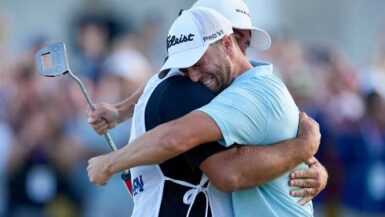
BROOKLINE, MA – Like a thoroughbred from the days when the Country Club’s golf holes were merely a horse racing oval, Northern Ireland’s Rory McIlroy sprinted out the gate at the 2022 U.S. Open. Bogeying only the last hole of his round, McIlroy posted a 3-under 67 early, stood atop the leaderboard with a fistful of others, and then watched and waited. As the sun set over Boston’s mighty granite outcroppings, only Canada’s Adam Hadwin had managed to catch and pass McIlroy and company to take the overnight lead by one stroke after a 4-under 66. Yet all the love at the Country Club Thursday was for Rory, and the vocal Boston fans buoyed him around the golf course with full-throated roars.
You’d have thought he was one of their beloved Boston Celtics.
“You’d take 67 around this golf course any day. Even though I’m standing up here slightly frustrated that I bogeyed the last, it’s a great start to the tournament,” McIlroy stated, allowing a bit of a smile break across his face. “I felt like I did most things well today. I certainly putted well, and I hit the ball in the right spots, and I hit a lot of greens, gave myself plenty of chances. Just basically did everything that you need to do at a U.S. Open.”
Indeed he did: the popular superstar who returned to the winner’s circle for the 21st time as a professional golfer just last weekend at the Canadian Open continued his sparkling wedge play and putting. Both clubs have been critical in his 2022 resurgence. Early in the season, (and for several previous seasons), Rory had struggled getting close with full wedge shots – the bread and butter of the Tour’s top echelon, but a bugaboo McIlroy couldn’t shake. During Rory’s dominance in 2011-2014 wedges were his money clubs and trophy clubs: drop the wedge next to the hole like a magic trick, hoist the trophy, cash the check, and drive off into the sunset. But for too long lately, Rory couldn’t get them closer than twelve feet and failed to convert the putt.
But since March, McIlroy has zoned in, his approach shots creeping ever closer to the pin. He’s now averaging eight feet per approach over his last four competitive rounds. He needed every lasered wedge and every center-cut putt for a 62 and a playoff victory last Sunday to catch and hold off Justin Thomas at the Canadian Open. Similarly, it was greens in regulation, hair-raising up-and-downs when he missed the green and a white-hot putter that vaulted McIlroy into contention after day one of the U.S. Open. Although he only hit 8 of 14 fairways he reached 13 of 18 greens in regulation, (tied for sixth in that statistic). And when he missed the green such as at the par-3 second or the short par-4 fifth, the short game ignited. He got up and down from Braintree and Gloucester, pitching out of a spinach patch and holing the putt to save par at the second, and then making a sand save after going from one greenside bunker to another at the fifth.
“One of the things over the years that I maybe haven’t done as well at U.S. Opens is when I’ve put myself in those sort of positions, like in that long rough on 2 or where I’ve found myself on 5, trying to be a little too heroic with the first shot and leaving it in there or just sort of completely getting it wrong, and then all of a sudden you’re scrambling to make a double. I think walking up to those greens, I was accepting of the fact that just give yourself a putt of 10, 15, 20 feet for par, and I feel like I’m putting well enough that I’ll have a chance to make those. That was sort of the mindset,” McIlroy confided earnestly. “To hole two putts like that and keep momentum going, that was huge, especially on 5. It’s a drivable par-4, you’re thinking of making birdie on it, and all of a sudden you’re scrambling for par. It was nice to make that putt there.”
It was those par saves and the corresponding momentum that kept him atop the leader board. Starting on the back nine, McIlroy opened his round with six straight pars before birdying 16 and 18, and turning in 2-under. He added birdies at 6 and 8, perceived by many as among the few holes where golfers can be aggressive, before carding his only blemish, a bogey at the 18th.
The gaggle joining McIlroy at 3-under requires a Spotter’s Guide at times. It includes Sweden’s David Lingmerth, South Africa’s MJ Daffue, England’s Callum Tarren and American Joel Dahmen, a cancer survivor and the only one of the four with a top-10 PGA Tour finish on his resume, (a T-10 finish at the 2010 PGA Championship). Among them, Dahmen also had the steadiest round, ranking second in fairways hit (12 out of 14 for 85.7%) and first overall in greens in regulation, (16 out of 18 for 88.8%).
As an aside, how can you not root for the cancer survivor? That’s the best story on the leaderboard.
(Lance Armstrong, I see you waving in the back of the room. Put your hand down and sit still.)
Meanwhile, Hedwin also finds himself in unfamiliar territory. Starting in the afternoon and with the wind kicking up, Hadwin birdied five out of six holes from four through eight to jump ahead of the logjam at 3-under, then held on to post his lowest career round in any major championships. This is Hadwin’s 20th career major championship start, but he has never finished inside the top-20 players in any of those events.
“I know this is U.S. Open. I know it’s difficult,” Hadwin observed. “I think in the past I may have sort of played too cautiously because it was a U.S. Open and said, I need to hit it up here and do that. Today I didn’t treat it like any other tournament. Sorry. I treated it like every other tournament. I got a wedge from 100 yards. I’m going to be aggressive. That was probably the biggest key to my success today.”
A sterling short game helped; Hadwin missed seven greens in regulation, but converted five of those opportunities. He balanced his six birdies against just two bogeys, (the long difficult par-4 third and the quirky narrow par-4 12th).
There were 25 players to record scores in the 60s on Thursday, tied for second-most in any opening round one in United States Open history, trailing only Pebble Beach in 2019, which had 27. The early wave had it visibly easier on the whole in round one, with 16 of the 25 rounds in the 60s coming from the first half of tee times. In all, the early wave averaged 72.51, about half-a-stroke lower than the players teeing off in the afternoon, making Hadwin’s round even more notable, or perhaps, to some, more of a statistical outlier.





